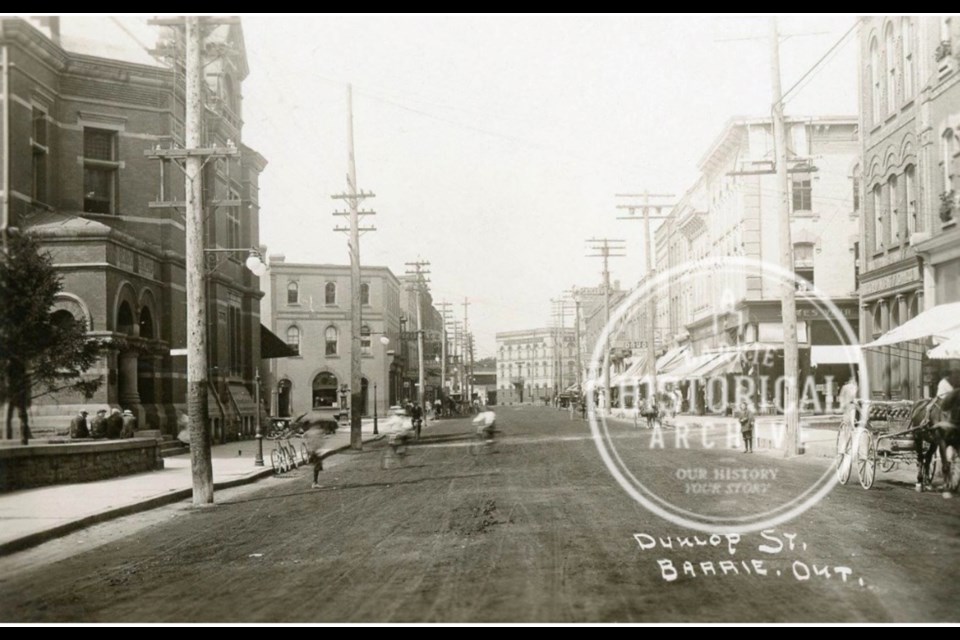In the late 1800s, the growing town of Barrie was desperate to separate itself from its backwoods reputation. To meet that end, the citizens of the town tried their best to keep up with the social advances of the big city to the south.
You know, if Toronto has it then Barrie must have it as well. That was the thinking. An opera house, a music hall, and a literary society were must-haves.
Another sign of a thriving and healthy community is organized sport and Barrie always came on strong in that department.
The Toronto Bicycle Club formed in 1881 and Barrie followed suit about four years later with the inauguration of the Barrie Bicycle and Athletics Club.
All of North America was in the midst of a full-on bicycle craze at the time. This two-wheeled invention, known earlier as a velocipede, had come to be seen as a symbol of freedom. Freedom from hitching up horses and from relying on others for transportation. A rider could simply just hop on and go and this was something completely new and extremely liberating.
Aside from the aspects of fun, fitness and short distance travel, cycling, or wheeling as it was often called, was definitely an athletic endeavour as well. Naturally, bicycle racing quickly rose in popularity.
Bicycle racing in the 1880s was almost entirely a man’s sport and very dangerous. What you need to realize is that the bicycles used at that time were mostly high wheels, more commonly referred to as ordinaries or pennyfarthings – those old-timey contraptions with the giant wheel in front.
Later, the safety bicycle was invented. It featured two wheels of the same size, just like the bikes we see today.
The fledgling Bicycle Club of Barrie was quick off the starting line. They petitioned the town for a dedicated quarter-mile bicycle race track to be constructed just inside the horse ring at Agricultural Park. They requested a cinder base, which was the preferred racing surface of the day.
In May, 1886, the Northern Advance detailed the first outing of the season for the Barrie Bicycle Club when three members took a jaunt up to Orillia.
“They found the wheeling good as far as Hawkestone, which place was made in two hours run, but here their difficulties began, the roads being too rough for wheeling and the rides were so few and far between, that the boys thought they would forget how to ride before they struck a good road.”
The lads eventually rode into Orillia five hours after leaving Barrie and wisely took the afternoon train home again after having a good lunch in a local hotel.
Barrie did produce one little known sports hero of the bicycling variety. In his day, he was the equal of Ned Hanlon of rowing fame, only on two wheels. He was no longer living in this area when he shot to fame, but we will claim him as our own anyway.
William ‘Bill’ Greatrex was the son of William Greatrex and Susannah Dew who had immigrated to Canada from England a couple of years before his 1874 birth. The family first settled in Bradford.
William Greatrex Sr. was a machinist and several of his half dozen sons also became machinists or tool makers. The family moved around the county making stops in Alliston and Barrie before spreading out even farther and landing in Toronto, Hamilton and western Canada.
In 1898, when Bill Greatrex married Henrietta Hall, he was employed as a bicycle builder in Toronto. When his marriage announcement appeared in the Northern Advance, the paper couldn’t resist adding that “Mr. Greatrex is the well known bicycle man. He was formerly a resident of Barrie.”
Indeed, by that time, Bill Greatrex had been scorching tracks and winning medals for more than a decade.
In 1887, under electric lights in a night race, Greatrex won the Corby Cup at Peterborough as a solo cyclist. He challenged competitors to a rematch and drew no takers.
In 1897 and 1898, Greatrex, who was then racing for the Queen City Bicycle Club of Toronto, posted the fastest times in the Dunlop Trophy Races.
Races were often run right through the streets of Toronto beginning at the Greenwood Racetrack grounds, then known as Woodbine, along Kingston Road and back again, for a total of seven miles.
Prizes ranged from cash and medals to custom-created furniture and watches.
No doubt, it would have been an exciting time to be one of the fastest cyclists on the continent during the peak of nineteenth century bicycle racing fever.
Each week, the Barrie Historical Archive provides BarrieToday readers with a glimpse of the city’s past. This unique column features photos and stories from years gone by and is sure to appeal to the historian in each of us.



